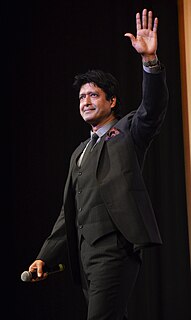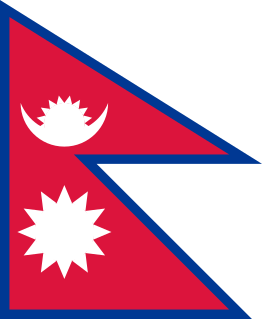The following is a list of libraries in Nepal.

Kathmandu, is the capital and the most populous city of Nepal with 845,767 inhabitants living in 105,649 households in 2021 and 2.9 million people in its urban agglomeration. It is located in the Kathmandu Valley, a large valley in the high plateaus in central Nepal, at an altitude of 1,400 metres. It is the second largest city proper in Himalayan hill region after Srinagar, and the largest Metropolitan region in the Himalayan hill region.

The politics of Nepal functions within the framework of a parliamentary republic with a multi-party system. Executive power is exercised by the Prime Minister and their cabinet, while legislative power is vested in the Parliament.

Nepal, officially the Federal Democratic Republic of Nepal, is a landlocked country in South Asia. It is mainly situated in the Himalayas, but also includes parts of the Indo-Gangetic Plain, bordering Tibet of China to the north, and India in the south, east, and west, while it is narrowly separated from Bangladesh by the Siliguri Corridor, and from Bhutan by the Indian state of Sikkim. Nepal has a diverse geography, including fertile plains, subalpine forested hills, and eight of the world's ten tallest mountains, including Mount Everest, the highest point on Earth. Nepal is a multi-ethnic, multi-lingual, multi-religious and multi-cultural state, with Nepali as the official language. Kathmandu is the nation's capital and the largest city.

Sher Bahadur Deuba is a Nepali politician serving as the prime minister of Nepal since 13 July 2021. He has also been serving as the president of the Nepali Congress since 2016. Deuba has previously served four terms as the prime minister and is the Member of Parliament for the parliamentary constituency of Dadeldhura 1.

Hinduism is the main and largest religion of Nepal. In 2007, the country declared itself a secular country through democracy; still, some special privileges were given to Indic religions like "The Constitution of Nepal has established a call for the protection of this age-old religion mostly referring to Indic religion throughout the country". According to the 2011 census, the Hindu population in Nepal is estimated to be around 21,551,492, which accounts for at least 81.34% of the country's population, the highest percentage of Hindus of any country in the world. The national calendar of Nepal, Vikram Samvat, is a solar Hindu calendar essentially the same to that widespread in North India as a religious calendar, and is based on Hindu units of time. Nepal remained the last Hindu country in the world until 2008, after the abolition of monarchy in the nation.

The Federal Parliament of Nepal is the bicameral federal and supreme legislature of Nepal established in 2018. It consists of the National Assembly and the House of Representatives as parallel houses.

Shukra Raj Shastri was a Nepalese intellectual and fighter for democracy who was executed by the autocratic Rana dynasty. He is one of the four martyrs of the Nepalese revolution that toppled the Rana regime. The other three are Dashrath Chand, Dharma Bhakta Mathema and Ganga Lal Shrestha.

Rajesh Hamal is a Nepali film actor, singer, model, and television host. He is regarded as one of the most influential and popular actors in the history of Nepalese cinema. He is popularly known as the "Maha Nayak" of Nepalese film Industry and the highest paid Nepali actors throughout the 1990s and 2000s, he is first Nepalese actor to receive popularity across South Asia. He holds several box office records in Nepali cinema including most commercially successful film as lead actor, most consecutive hits and most awards as an actor.

Kasthamandap was a three-storied public shelter that included a shrine consecrated to Gorakshanath situated at Maru, Kathmandu, Nepal. Several myths and stories about the date of the construction of the Kasthamandap have been resolved with the recent archeological findings: newly discovered objects during the excavation in the aftermath of the 2015 earthquake have suggested that the Kasthamandap may have been built in the 7th century during the Lichhavi era.

Janakpurdham or Janakpur is a sub-metropolitan city in Dhanusa District, Madhesh Province, Nepal. The city is a hub for religious and cultural tourism. A headquarter of Dhanusha district, Janakpur is also the capital for Madhesh Province.

India–Nepal relations are the bilateral relations between India and Nepal. Both countries initiated their relationship with the 1950 Indo-Nepal Treaty of Peace and Friendship and accompanying secret letters that defined security relations between the two countries, and an agreement governing both bilateral trade and trade transiting Indian territory. The 1950 treaty and letters exchanged between the then Indian government and Rana rulers of Nepal, stated that "neither government shall tolerate any threat to the security of the other by a foreign aggressor" and obligated both sides "to inform each other of any serious friction or misunderstanding with any neighboring state likely to cause any breach in the friendly relations subsisting between the two governments." These accords cemented a "special relationship" between India and Nepal. The treaty also granted Nepalese the same economic and educational opportunities as Indian citizens in India, while accounting for preferential treatment to Indian citizens and businesses compared to other nationalities in Nepal. The Indo-Nepal border is open; Nepalese and Indian nationals may move freely across the border without passports or visas and may live and work in either country. However, Indians are not allowed to own land-properties or work in government institutions in Nepal, while Nepalese nationals in India are allowed to work in some Indian government institutions notably the Indian military. An estimated 32,000 Nepalese citizens are employed as active duty soldiers in the Indian army and further 1 million Nepali-migrant workers are believed to be spread throughout India while Indian embassy in Nepal has reported that 600,000 Indian citizens in Nepal have registered their paperwork with the Indian embassy in Kathmandu as of 2021. The Election commission of Nepal however have published a lower figure of only 562,456 Nepali citizens in India as of 2021, eligible to vote in the upcoming Federal elections of 2022 in Nepal. The number of Indian immigrants in Nepal who haven't registered their paperwork with the Indian embassy in Kathmandu isn't known as of 2021.

Khadga Prasad Sharma Oli is a Nepalese politician and former Prime Minister of Nepal. He served three terms as prime minister from 11 October 2015 to 3 August 2016, from 15 February 2018 to 13 May 2021 as the first elected prime minister under the new constitution, and from 13 May 2021 to 13 July 2021.

The banishment of Buddhist monks from Nepal was part of a campaign by the Rana government to suppress the resurgence of Theravada Buddhism in Nepal in the early the 20th century. There were two deportations of monks from Kathmandu, in 1926 and 1944.

Bagmati Province is one of the seven provinces of Nepal established by the constitution of Nepal. The province is Nepal's second-most populous province and fifth largest province by area. Bagmati is bordered by Tibet Autonomous Region of China to the north, Gandaki Province to the west, Province No. 1 to the east, Indian state of Bihar and Madhesh Province to the south. With Hetauda as its provincial headquarter, the province is also the home to the country's capital Kathmandu, is mostly hilly and mountainous, and hosts mountain peaks including Gaurishankar, Langtang, Jugal, and Ganesh.
The COVID-19 pandemic in Nepal is part of the worldwide pandemic of coronavirus disease 2019 caused by severe acute respiratory syndrome coronavirus 2. The first case in Nepal was confirmed on 23 January 2020 when a 31-year-old student, who had returned to Kathmandu from Wuhan on 9 January, tested positive for the disease. It was also the first recorded case of COVID-19 in South Asia. Nepal's first case of local transmission was confirmed on 4 April in Kailali District. The first death occurred on 14 May. A country-wide lockdown came into effect on 24 March 2020, and ended on 21 July 2020. As of 8 March 2022, the Ministry of Health and Population (MoHP) has confirmed a total of 977,641 cases, 959,817 recoveries, and 11,949 deaths in the country. In the meantime, 5,455,858 real-time RT-PCR (RT-qPCR) tests have been performed in 40 laboratories across the country. The viral disease has been detected in all provinces and districts of the country, with Bagmati Province and Kathmandu being the worst hit province and district respectively. As for Nepalese abroad, as of 26 July 2020, the Non-Resident Nepali Association has reported a total of 12,667 confirmed cases, 16,190 recoveries, and 161 deaths across 35 countries.
The following is the timeline of the COVID-19 pandemic in Nepal.

Corruption in Nepal is widespread and extends to every sector from the government to the judiciary, police, health services, and education. Nepal ranks at 117 in Transparency International's 2021 Corruption Perceptions Index, unchanged from its 2020 ranking. The Corruption Perceptions Index ranks 180 countries by the degree of perceived corruption in the public sector; the country whose public sector is perceived to be most honest is ranked first.